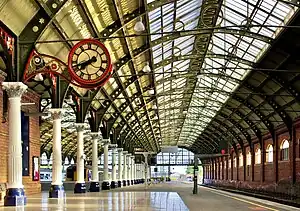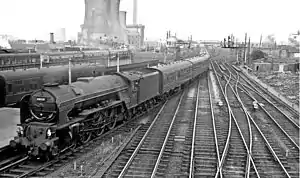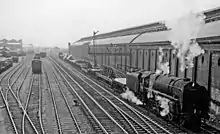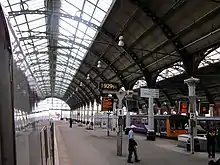Darlington | |
|---|---|
 Station concourse and platforms | |
| General information | |
| Location | Darlington, County Durham, England |
| Coordinates | 54°31′15″N 1°32′48″W / 54.5207294°N 1.5466938°W |
| Grid reference | NZ294140 |
| Owned by | Network Rail |
| Managed by | London North Eastern Railway |
| Platforms | 4 |
| Tracks | 4 (2 bay platform) |
| Other information | |
| Station code | DAR |
| Classification | DfT category B |
| History | |
| Original company | North Eastern Railway |
| Pre-grouping | North Eastern Railway |
| Post-grouping | |
| Key dates | |
| 31 March 1841 | Opened as Darlington |
| 1 October 1868 | Renamed Darlington Bank Top |
| 1 July 1887 | Resited |
| 1 September 1934 | Renamed Darlington |
| 2025 | Increase from four to six platforms |
| Passengers | |
| 2018/19 | |
| Interchange | |
| 2019/20 | |
| Interchange | |
| 2020/21 | |
| Interchange | |
| 2021/22 | |
| Interchange | |
| 2022/23 | |
| Interchange | |
Listed Building – Grade II* | |
| Feature | Original North Eastern Railway station building |
| Designated | 6 September 1977 |
| Reference no. | 1310079[1] |
| Location | |
| Notes | |
Passenger statistics from the Office of Rail and Road | |
Darlington railway station is on the East Coast Main Line serving the town of Darlington, County Durham, England. It is 232 miles 50 chains (232.63 miles; 374.37 kilometres) north of London King's Cross. It is situated between Northallerton to the south and Durham to the north. Its three-letter station code is DAR.
The station is well served, since it is an important stop for main line services, with trains being operated by London North Eastern Railway, CrossCountry and TransPennine Express, and it is the interchange for Northern services to Bishop Auckland, Middlesbrough and Saltburn. Darlington is the location of the first commercial steam railway: the Stockton and Darlington Railway. The station building is a Grade II* listed[1] Victorian structure and winner of the "Large Station of the Year" award in 2005.[2]
History
The first railway to pass through the area now occupied by the station was built by the Stockton and Darlington Railway, who opened their mineral branch from Albert Hill Junction on their main line to Croft-on-Tees on 27 October 1829. This branch line was subsequently purchased by the Great North of England Railway a decade later to incorporate into their new main line from York which reached the town on 30 March 1841. A separate company, the Newcastle & Darlington Junction Railway continued the new main line northwards towards Ferryhill and Newcastle, opening its route three years later on 19 June 1844.[3] This crossed the S&D at Parkgate Junction by means of a flat crossing which would in future years become something of an operational headache for the North Eastern Railway and LNER. The original Bank Top station where the two routes met was a modest affair, which was rebuilt in 1860 to accommodate the expanding levels of traffic on the main line. By the mid-1880s even this replacement structure was deemed inadequate and so the NER embarked on a major upgrade to facilities in the area. This included an ornate new station with an impressive three-span overall roof on the Bank Top site, new sidings and goods lines alongside it and a new connecting line from the south end of the station (Polam Junction) to meet the original S&D line towards Middlesbrough at Oak Tree Junction near Dinsdale. These improvements were completed on 1 July 1887, when the old route west of Oak Tree closed to passengers (although it remained in use for freight until 1967).

The new station, with its broad island platform was designed by T. E. Harrison, chief engineer, and William Bell, the architect of the North Eastern Railway.[4] It cost £81,000 (equivalent to £9,580,000 in 2021)[5] to construct.[6] It soon became a busy interchange on the main East Coast route, thanks to its rail links to Richmond (opened in 1846), Barnard Castle and Penrith (1862/5) and the Tees Valley Line to Bishop Auckland (1842) and Saltburn (1861).

The lines to Penrith (closed in 1962), Barnard Castle (1964)[7] and Richmond (1969) have now gone (along with the bays at the northern end of the station, now used for car parking), but the main line (electrified in 1991) and the Tees Valley route remain busy. It is also still possible to travel to Catterick Garrison and Richmond from here, by means of the Arriva North East-operated X26 and X27 buses (which have through National Rail ticketing arrangements). The same company also operated the Sky Express bus service to Durham Tees Valley Airport from the station, but this was withdrawn in January 2009 due to declining demand.[8]
Station masters
- Thomas Waldie: 1840–1866[9]
- Robert Wood: 1867–1873[10]
- Richard Thompson: 1874–1878
- James Bell: 1878–1900[11]
- Thomas William Smith: 1900–1902[12] (afterwards station master at Sunderland)
- G. H. Stephenson: 1902[13]
- George W. T. Laidler: 1902[14] - 1907
- J. Pattinson: 1907
- Matthew William Seymour: 1907–1912 (formerly station master at Bishop Auckland, afterwards station master at Boroughbridge)
- T. Pearce: 1912–1920
- Irving Richard Beeby MBE: 1920–1931
- Edwin Weavers: 1932–1941[15] (formerly station master at Middlesbrough)
- Thomas Allen: 1942[16]–1949 (formerly station master at Sunderland)
- W. Lake: 1950
- W. H. Campbell: 1950–1952 (afterwards station master at Newcastle)
- W. J. Thomas: 1952–1956
- George Renton: 1956[17]
- N. Darby: 1963–????
- T. Hutchinson: 1965
- S. F. Potts: 1965–????
Accidents and incidents
- On 16 November 1910, an express freight train overran signals and was involved in a rear-end collision with another freight train.[18]
- On 27 June 1928, a parcels train and an excursion train were involved in a head-on collision. 25 people were killed and 45 were injured.[19]
- On 11 December 1968, a Newcastle to Kings Cross express train was derailed at the south end of the station after passing a signal at danger. No-one was hurt.[20]
- On 16 February 1977, an express passenger train hauled by Class 55 locomotive 55 008 collided with an empty stock train after failing to stop at Darlington. The guard of the express was slightly injured. The cause of the accident was that the brakes on the carriages had become isolated whilst the train was moving in a freak event. The train had struck an object on the track, which had caused a traction motor cover to come lose. This struck the handle of the brake isolating cock, closing it and thus separating the brakes between the locomotive and train. Following the collision, the train was diverted onto the Tees Valley line, where it was brought to a halt by the operation of the communication cord in one of the carriages.[21]
- On 3 October 2009, a Class 142 unit, operated by Northern Rail, hit the rear end of a departing National Express East Coast service. Three passengers from the Northern Rail train were taken to hospital with minor injuries.[22][23]
.jpg.webp)
Facilities
The station is fully staffed; the ticket office is open throughout the week (06:00–20:00/21:00 weekdays, 06:30–19:45 Saturdays, 07:45–20:00 Sundays). There is a waiting room and a first class Lounge on the platform, with the lounge open between 06:00 and 20:00 each day (except Sundays, when it opens at 08:00). Self-service ticket machines are also provided for use outside the opening hours for the booking office and for collecting pre-paid tickets. Various retail outlets are located in the main buildings, including a coffee shop, grocers and newsagents. Vending machines, toilets, a photo booth, payphone and cash machines are also provided. Train running information is offered via digital CIS displays, announcements and timetable posters. Step-free access to all platforms is via ramps from the subway linking the platforms with the main entrance and car park.[24]
Services
Northern Trains Route 2 | ||||||||||||||||||||||||||||||||||||||||||||||||||||||||||||||||||||||||||||||||||||
|---|---|---|---|---|---|---|---|---|---|---|---|---|---|---|---|---|---|---|---|---|---|---|---|---|---|---|---|---|---|---|---|---|---|---|---|---|---|---|---|---|---|---|---|---|---|---|---|---|---|---|---|---|---|---|---|---|---|---|---|---|---|---|---|---|---|---|---|---|---|---|---|---|---|---|---|---|---|---|---|---|---|---|---|---|
Durham Coast Line | ||||||||||||||||||||||||||||||||||||||||||||||||||||||||||||||||||||||||||||||||||||
| ||||||||||||||||||||||||||||||||||||||||||||||||||||||||||||||||||||||||||||||||||||
Northern Trains Route 3 | |||||||||||||||||||||||||||||||||||||||||||||||||||||||||||||||||||||||||||||||||||||||||||||||||||||||||||||||||||||||||||||||||||||
|---|---|---|---|---|---|---|---|---|---|---|---|---|---|---|---|---|---|---|---|---|---|---|---|---|---|---|---|---|---|---|---|---|---|---|---|---|---|---|---|---|---|---|---|---|---|---|---|---|---|---|---|---|---|---|---|---|---|---|---|---|---|---|---|---|---|---|---|---|---|---|---|---|---|---|---|---|---|---|---|---|---|---|---|---|---|---|---|---|---|---|---|---|---|---|---|---|---|---|---|---|---|---|---|---|---|---|---|---|---|---|---|---|---|---|---|---|---|---|---|---|---|---|---|---|---|---|---|---|---|---|---|---|---|
Tees Valley Line | |||||||||||||||||||||||||||||||||||||||||||||||||||||||||||||||||||||||||||||||||||||||||||||||||||||||||||||||||||||||||||||||||||||
| |||||||||||||||||||||||||||||||||||||||||||||||||||||||||||||||||||||||||||||||||||||||||||||||||||||||||||||||||||||||||||||||||||||
Darlington is well served by trains on the East Coast Main Line, with regular trains southbound to London King's Cross via York and northbound to Newcastle and Edinburgh Waverley operated by London North Eastern Railway. Two trains per hour run south to London and north to Edinburgh Waverley. There are also several daily services to Aberdeen and also daily direct services to Stirling (two) and Inverness (one).[25] Due to the introduction of the new ECML timetable on 22 May 2011, LNER only now provide one daily direct service each way between London King's Cross and Glasgow Central which calls at Darlington. The northbound service to Glasgow departs Darlington at 18:09 and the southbound service from Glasgow arrives into Darlington at 10:00.[26]
CrossCountry services between Edinburgh, Newcastle and Sheffield, Birmingham New Street and beyond to (Reading and to Bristol Temple Meads, Exeter St Davids, Plymouth and Penzance) also call here twice each hour. Certain CrossCountry trains extend beyond Edinburgh to Glasgow Central, Dundee or Aberdeen.
TransPennine Express run one train per hour in each direction. Northbound; one service runs to Newcastle. Southbound; one service runs to Liverpool Lime Street via York, Leeds, Huddersfield, Manchester Victoria and Newton-le-Willows . [27]
Northern run their Tees Valley line trains twice hourly to Middlesbrough, Redcar's stations and Saltburn (hourly on Sundays), whilst the Bishop Auckland branch has a service every hour (including Sundays).[28] The company also operates two Sundays-only direct trains to/from Stockton and Hartlepool.
Platforms

Darlington railway station has five main platforms:
- Platform 1: This is the main southbound platform, with, in order of frequency, London North Eastern Railway services to York and London King's Cross, CrossCountry services to Reading and Southampton or Birmingham and Plymouth, via York and Leeds, TransPennine Express services to Manchester Piccadilly and Manchester Airport or Liverpool Lime Street, via York and Leeds, and Northern services to Saltburn via Middlesbrough, from Bishop Auckland.
- Platforms 2 and 3: These platforms are south-facing bays used exclusively by Northern services terminating at Darlington from Saltburn and Middlesbrough. Platform 2 is used most frequently.
- TransPennine Express trains also terminate in Platforms 2 & 3 when there are delays in order to allow them to run their southbound services back on time.
- Platform 4: This is the main northbound platform, with, in order of frequency, London North Eastern Railway services to Newcastle, Edinburgh and Glasgow, CrossCountry services to Newcastle, Edinburgh and Glasgow, TransPennine Express services to Newcastle and Northern services to Bishop Auckland.
- Platform 4a: This is a southern extension of platform four catering for trains waiting at Darlington such that they can be bypassed by trains stopping at platform 4. It is the only platform that is not under the station roof. It is used predominantly by Northern services for Bishop Auckland. Since the introduction of Class 802, TransPennine Express will use Platform 4a if they need to terminate early whilst using one of these trains due to Platform 2 & 3 not being electrified.
Future
Six platforms
As part of the Tees Valley Metro, two new platforms were to be built on the eastern edge of the main station. There were to be a total of four trains per hour, to Middlesbrough and Saltburn via the Tees Valley Line, and trains would not have to cross the East Coast Main Line when the new platforms would have been built. The Tees Valley Metro project was cancelled with some parts of the project ultimately followed through in other projects.
HS2 trains were originally due to stop at Darlington as part of the eastern leg, but this is in doubt as phase 2b was cancelled as part of the Integrated Rail Plan, and the entirety of the second phase of HS2 was cancelled in 2023.[29]
The station is currently undergoing redevelopment, with the construction of a new concourse, multi story car park and two new platforms on the current freight avoiding lines.[30]
References
- 1 2 Historic England. "Bank Top Railway Station (Main Building) (1310079)". National Heritage List for England. Retrieved 11 December 2014.
- ↑ "It's a hat-trick for award-winning GNER". Great North Eastern Railway. 2 September 2005.
- ↑ Body, p.56
- ↑ "Darlington New Railway Station". Leeds Mercury. England. 1 July 1887. Retrieved 29 December 2016 – via British Newspaper Archive.
- ↑ UK Retail Price Index inflation figures are based on data from Clark, Gregory (2017). "The Annual RPI and Average Earnings for Britain, 1209 to Present (New Series)". MeasuringWorth. Retrieved 11 June 2022.
- ↑ Body, p.60
- ↑ Body, p.58
- ↑ Tees Valley Airport - Airport Bus Service Comes to An End Archived 21 July 2011 at the Wayback Machine Tees Valley Airport Media Centre; Retrieved 30 January 2009
- ↑ "Presentation". York Herald. England. 5 January 1867. Retrieved 9 September 2017 – via British Newspaper Archive.
- ↑ "Death of Mr. Wood Stationmaster Darlington". Northern Echo. England. 7 June 1873. Retrieved 9 September 2017 – via British Newspaper Archive.
- ↑ "The Darlington Station Master". Northern Echo. England. 19 February 1900. Retrieved 9 September 2017 – via British Newspaper Archive.
- ↑ "Mr. T.W. Smith". Yorkshire Evening Post. England. 5 February 1902. Retrieved 9 September 2017 – via British Newspaper Archive.
- ↑ "Mr. G. Stephenson". Leeds Mercury. England. 22 February 1902. Retrieved 9 September 2017 – via British Newspaper Archive.
- ↑ "The New Stationmaster at Darlington". Yorkshire Post and Leeds Intelligencer. England. 19 April 1902. Retrieved 9 September 2017 – via British Newspaper Archive.
- ↑ "Darlington Loses Stationmaster". Newcastle Journal. England. 18 December 1941. Retrieved 9 September 2017 – via British Newspaper Archive.
- ↑ "Wearside Echoes". Sunderland Daily Echo and Shipping Gazette. England. 21 February 1942. Retrieved 9 September 2017 – via British Newspaper Archive.
- ↑ "For Darlington". Berwickshire News and General Advertiser. England. 6 March 1956. Retrieved 9 September 2017 – via British Newspaper Archive.
- ↑ Hoole (1982), pp16-17.
- ↑ Hoole (1982), p27.
- ↑ "Accident at Darlington on 11th December 1968" Railways Archive
- ↑ "Report on the collision that occurred on 16th February 1977 at Darlington in the Eastern Region of British Railways" (PDF). Department of Transport. 13 July 1978. Retrieved 2 August 2019.
- ↑ Trains collide at rail platform; BBC News website Retrieved 9 October 2009
- ↑ "Report 10/2010 Collision at Exeter St Davids station 4 January 2010" (PDF). Rail Accidents Investigation Branch. para. 70. Retrieved 13 February 2010.
- ↑ Darlington station facilities National Rail Enquiries; Retrieved 15 February 2017
- ↑ GB National Rail Timetable May 2018 Edition, Table 26
- ↑ "Our timetables". www.lner.co.uk. Retrieved 24 December 2023.
- ↑ "Loading..." timetables.tpexpress.co.uk. Retrieved 24 December 2023.
- ↑ Table 44 National Rail timetable, May 2018
- ↑ "What Next for HS2". House of Commons Library. Retrieved 25 December 2023.
- ↑ "Darlington Station 2025 - A New Future". Tees Valley. Retrieved 25 December 2023.
Sources
- Body, G. (1988), PSL Field Guides – Railways of the Eastern Region Volume 2, Patrick Stephens Ltd, Wellingborough, ISBN 1-85260-072-1
- Hoole, Ken (1982). Trains in Trouble: Vol. 3. Redruth: Atlantic Books. ISBN 0-906899-05-2.
External links
 Media related to Darlington railway station at Wikimedia Commons
Media related to Darlington railway station at Wikimedia Commons- Train times and station information for Darlington railway station from National Rail
| Preceding station | Following station | |||
|---|---|---|---|---|
| CrossCountry | ||||
| TransPennine Express North TransPennine | ||||
| Northallerton | London North Eastern Railway East Coast Main Line |
Durham | ||
| York | London North Eastern Railway London-Newcastle/Edinburgh/Scotland express or Leeds-Aberdeen |
Newcastle | ||
| Northern | ||||
| Future services | ||||
| York | High Speed 2 High Speed 2(Phase 2b) |
Newcastle | ||
| York | TBA Northern Powerhouse Rail |
Newcastle | ||
| Historical railways | ||||
| Croft Spa Line open, station closed |
North Eastern Railway York, Newcastle and Berwick Railway |
Aycliffe Line open, station closed | ||